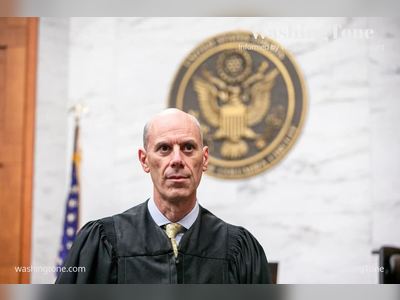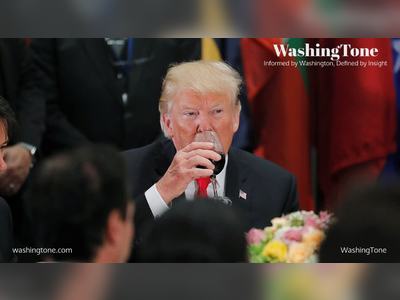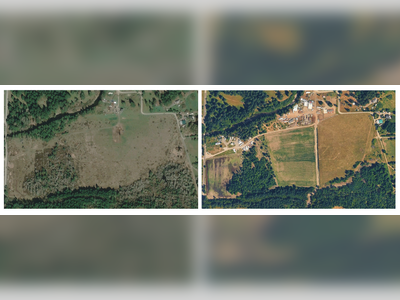White HouseSenateThe HouseSupreme CourtFederal ReserveDOJState DepartmentTreasuryCensusBudget OfficeTrade Representative
WashingTone
Informed by Washington, Defined by Insight
Thursday, Jul 17, 2025
WashingTone
Federal Reserve Renovation Draws Political Scrutiny Amid Trump's Renewed Criticism of Powell
A long-planned overhaul of the Federal Reserve’s Washington headquarters becomes a focal point in Donald Trump’s intensified campaign to remove Fed Chair Jerome Powell if re-elected
The Federal Reserve’s headquarters in Washington, D.C., currently undergoing a multiyear renovation, has become a topic of increased political focus following President Donald Trump’s renewed criticism of Federal Reserve Chair Jerome Powell.
The modernization effort, which began in 2022, includes structural upgrades, improved security measures, and updated facilities for the Marriner S.
Eccles Building and adjacent structures used by the U.S. central bank.
The renovation project, originally estimated to cost around $300 million, involves extensive infrastructure work expected to last several years.
The Federal Reserve Board temporarily relocated many of its operations to leased spaces nearby while the primary buildings undergo retrofitting.
The scope includes enhanced cybersecurity systems, mechanical upgrades, and accessibility improvements in line with federal building standards.
The project remained largely under the radar until recent remarks by Donald Trump, who has publicly expressed disapproval of Powell’s leadership, particularly over interest rate decisions.
Trump, who nominated Powell to the role in 2017, has repeatedly criticized the Fed’s handling of inflation and monetary policy.
He has stated that, if re-elected in the 2024 presidential election, he would seek to remove Powell from his post prior to the end of Powell’s second term, which expires in May 2026.
Under U.S. law, the President cannot directly remove the Federal Reserve Chair without cause.
The Fed’s independence from the executive branch is safeguarded by statute, with the Chair serving a four-year term that may overlap presidential administrations.
Powell, originally appointed by Trump, was later renominated by President Joe Biden in 2021 and confirmed by the Senate in 2022.
The increased scrutiny over the renovation project comes amid heightened debate around the Fed’s interest rate policy.
Between March 2022 and July 2023, the Federal Reserve raised benchmark interest rates 11 times in an effort to curb inflation, bringing rates to their highest levels in over two decades.
Though inflation has eased in recent months, the Fed has maintained a cautious stance, indicating that future rate cuts will depend on sustained economic indicators.
Political commentary surrounding the Fed’s physical presence in Washington has intensified as the building remains largely vacant during renovations.
The project’s visibility has grown amid broader partisan debates over central bank autonomy, transparency, and the institution’s role in shaping economic conditions during and after the COVID-19 pandemic.
Congressional oversight of the Federal Reserve has included questions about the cost, necessity, and duration of the renovation, though the project itself was internally approved by the Board prior to Trump’s recent remarks.
The timeline for completion currently extends into 2026, with phased occupancy expected as renovations conclude.
Powell continues to lead the central bank through a period of close scrutiny, balancing inflation targets with labor market performance and economic growth.
The Fed’s communications have emphasized data-dependence and long-term stability, as global markets monitor signals about the direction of U.S. monetary policy.
The modernization effort, which began in 2022, includes structural upgrades, improved security measures, and updated facilities for the Marriner S.
Eccles Building and adjacent structures used by the U.S. central bank.
The renovation project, originally estimated to cost around $300 million, involves extensive infrastructure work expected to last several years.
The Federal Reserve Board temporarily relocated many of its operations to leased spaces nearby while the primary buildings undergo retrofitting.
The scope includes enhanced cybersecurity systems, mechanical upgrades, and accessibility improvements in line with federal building standards.
The project remained largely under the radar until recent remarks by Donald Trump, who has publicly expressed disapproval of Powell’s leadership, particularly over interest rate decisions.
Trump, who nominated Powell to the role in 2017, has repeatedly criticized the Fed’s handling of inflation and monetary policy.
He has stated that, if re-elected in the 2024 presidential election, he would seek to remove Powell from his post prior to the end of Powell’s second term, which expires in May 2026.
Under U.S. law, the President cannot directly remove the Federal Reserve Chair without cause.
The Fed’s independence from the executive branch is safeguarded by statute, with the Chair serving a four-year term that may overlap presidential administrations.
Powell, originally appointed by Trump, was later renominated by President Joe Biden in 2021 and confirmed by the Senate in 2022.
The increased scrutiny over the renovation project comes amid heightened debate around the Fed’s interest rate policy.
Between March 2022 and July 2023, the Federal Reserve raised benchmark interest rates 11 times in an effort to curb inflation, bringing rates to their highest levels in over two decades.
Though inflation has eased in recent months, the Fed has maintained a cautious stance, indicating that future rate cuts will depend on sustained economic indicators.
Political commentary surrounding the Fed’s physical presence in Washington has intensified as the building remains largely vacant during renovations.
The project’s visibility has grown amid broader partisan debates over central bank autonomy, transparency, and the institution’s role in shaping economic conditions during and after the COVID-19 pandemic.
Congressional oversight of the Federal Reserve has included questions about the cost, necessity, and duration of the renovation, though the project itself was internally approved by the Board prior to Trump’s recent remarks.
The timeline for completion currently extends into 2026, with phased occupancy expected as renovations conclude.
Powell continues to lead the central bank through a period of close scrutiny, balancing inflation targets with labor market performance and economic growth.
The Fed’s communications have emphasized data-dependence and long-term stability, as global markets monitor signals about the direction of U.S. monetary policy.









